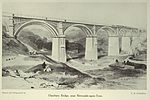Victoria Tunnel (Newcastle)

The Victoria Tunnel is a subterranean waggonway that runs under Newcastle upon Tyne, England, from the Town Moor down to the River Tyne. It was built between 1839 and 1842 to transport coal from Leazes Main Colliery in Spital Tongues to riverside staithes (jetties) ready for loading onto boats for export. The tunnel was driven through boulder clay and formed by a base course of stone supporting a brick arch. Loaded wagons descended the incline of the tunnel under their own weight, and were rope-hauled back to the colliery by a stationary engine. The colliery closed in January 1860 and the tunnel was abandoned until the start of the Second World War when it was converted for use as an air-raid shelter. The tunnel is 2.4 miles (3.9 km) in length with a maximum depth of 85 feet (26 m) and drops 222 feet (68 m) from entrance to exit. It remains largely intact.
Excerpt from the Wikipedia article Victoria Tunnel (Newcastle) (License: CC BY-SA 3.0, Authors, Images).Victoria Tunnel (Newcastle)
Lime Street, Newcastle upon Tyne Battle Field
Geographical coordinates (GPS) Address Website Nearby Places Show on map
Geographical coordinates (GPS)
| Latitude | Longitude |
|---|---|
| N 54.9731 ° | E -1.5914 ° |
Address
Backyard Bike Shop
Lime Street 21
NE1 2PQ Newcastle upon Tyne, Battle Field
England, United Kingdom
Open on Google Maps








